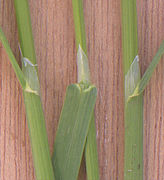Poaceae
| Grasses Temporal range: [1]
| |
|---|---|
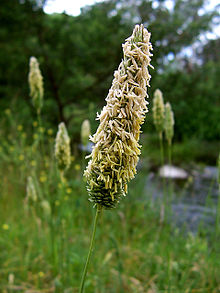
| |
| Flowering head of meadow foxtail (Alopecurus pratensis), with stamens exerted at anthesis | |
| Scientific classification | |
| Kingdom: | Plantae |
| Clade: | Tracheophytes |
| Clade: | Angiosperms |
| Clade: | Monocots |
| Clade: | Commelinids |
| Order: | Poales |
| Clade: | Graminid clade |
| Family: | Poaceae Barnhart[2] |
| Type genus | |
| Poa | |
| Subfamilies | |
| |
| Synonyms[3] | |
|
Gramineae | |
Poaceae (/poʊˈeɪsiaɪ, -siːiː/) or Gramineae (/ɡrəˈmɪniaɪ/) is a large and nearly ubiquitous family of monocotyledonous flowering plants commonly known as grasses. It includes the cereal grasses, bamboos, the grasses of natural grassland and species cultivated in lawns and pasture. The latter are commonly referred to collectively as grass.
With around 780
The Poaceae are the most economically important plant family, providing
Grasses have
Though they are commonly called "grasses", groups such as the
Description
Grasses may be

Growth and development
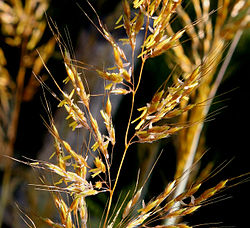
Grass blades grow at the base of the blade and not from elongated stem tips. This low growth point evolved in response to grazing animals and allows grasses to be
Three general classifications of growth habit present in grasses: bunch-type (also called caespitose), stoloniferous, and rhizomatous.[12] The success of the grasses lies in part in their morphology and growth processes and in part in their physiological diversity. There are both
The C3 grasses are referred to as "cool-season" grasses, while the C4 plants are considered "warm-season" grasses.[8]: 18–19
- Annual cool-season – wheat, rye, annual bluegrass (annual meadowgrass, Poa annua), and oat
- Perennial cool-season – orchardgrass (cocksfoot, Kentucky bluegrass and perennial ryegrass (Lolium perenne)
- Annual warm-season – sudangrass, and pearl millet
- Perennial warm-season – switchgrass.
Although the C4 species are all in the
Taxonomy
The name Poaceae was given by
Evolutionary history
Grasses include some of the most versatile
A cladogram shows subfamilies and approximate species numbers in brackets:[14]
| |||||||||||||||||||||||||||||||||||||||||||||||||||||||||||||||||||
Before 2005, fossil findings indicated that grasses evolved around 55 million years ago. Finds of grass-like phytoliths in Cretaceous dinosaur coprolites from the latest Cretaceous (Maastrichtian) aged Lameta Formation of India have pushed this date back to 66 million years ago.[18][19] In 2011, fossils from the same deposit were found to belong to the modern rice tribe Oryzeae, suggesting substantial diversification of major lineages by this time.[20]
In 2018, a study described grass microfossils extracted from the teeth of the hadrosauroid dinosaur Equijubus normani from northern China, dating to the Albian stage of the Early Cretaceous approximately 113–100 million years ago, which were found to belong to primitive lineages within Poaceae, similar in position to the Anomochlooideae. These are currently the oldest known grass fossils.[1]
The relationships among the three subfamilies Bambusoideae, Oryzoideae and Pooideae in the BOP clade have been resolved: Bambusoideae and Pooideae are more closely related to each other than to Oryzoideae.[21] This separation occurred within the relatively short time span of about 4 million years.
According to Lester Charles King, the spread of grasses in the Late Cenozoic would have changed patterns of hillslope evolution favouring slopes that are convex upslope and concave downslope and lacking a free face were common. King argued that this was the result of more slowly acting surface wash caused by carpets of grass which in turn would have resulted in relatively more soil creep.[22][23]
Subdivisions
There are about 12,000 grass species in about 771 genera that are classified into 12 subfamilies.[24] See the full list of Poaceae genera.
- Anomochlooideae Pilg. ex Potztal, a small lineage of broad-leaved grasses that includes two genera (Anomochloa, Streptochaeta)
- Pharoideae L.G.Clark & Judz., a small lineage of grasses of three genera, including Pharus and Leptaspis
- Puelioideae L.G.Clark, M.Kobay., S.Mathews, Spangler & E.A.Kellogg, a small lineage of the African genus Puelia
- bluegrass(Poa)

- Bambusoideae, including bamboo
- Aristidoideae, including Aristida
- common reed
- Chloridoideae, including the lovegrasses (Eragrostis, about 350 species, including teff), dropseeds (Sporobolus, some 160 species), finger millet (Eleusine coracana (L.) Gaertn.), and the muhly grasses (Muhlenbergia, about 175 species)
- Micrairoideae
- Danthonioideae, including pampas grass
Distribution
The grass family is one of the most widely distributed and abundant groups of plants on Earth. Grasses are found on every continent,[25][26] including Antarctica. The Antarctic hair grass, Deschampsia antarctica is one of only two plant species native to the western Antarctic Peninsula.
Ecology

Grasses are the
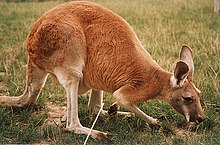
Grasses dominate certain biomes, especially temperate grasslands, because many species are adapted to grazing and fire.[32]
Grasses are unusual in that the meristem is near the bottom of the plant; hence, grasses can quickly recover from cropping at the top.[33] The evolution of large grazing animals in the Cenozoic contributed to the spread of grasses. Without large grazers, fire-cleared areas are quickly colonized by grasses, and with enough rain, tree seedlings. Trees eventually outcompete most grasses. Trampling grazers kill seedling trees but not grasses.[11]: 137
Uses
Grasses are, in human terms, perhaps the most economically important plant family.
Food production
Of all crops grown, 70% are grasses.
Sugarcane is the major source of sugar production. Additional food uses of sugarcane include sprouted grain, shoots, and rhizomes, and in drink they include sugarcane juice and plant milk, as well as rum, beer, whisky, and vodka.
Bamboo shoots are used in numerous Asian dishes and broths, and are available in supermarkets in various sliced forms, in both fresh, fermented and canned versions.
Many species of grass are grown as pasture for foraging or as fodder for prescribed livestock feeds, particularly in the case of cattle, horses, and sheep. Such grasses may be cut and stored for later feeding, especially for the winter, in the form of bales of hay or straw, or in silos as silage. Straw (and sometimes hay) may also be used as bedding for animals.
An example of a sod-forming perennial grass used in agriculture is Thinopyrum intermedium.
Industry
Grasses are used as raw material for a multitude of purposes, including construction and in the composition of building materials such as
Phragmites australis (common reed) is important for thatching and wall construction of homes in Africa.[40] Grasses are used in water treatment systems,[41] in wetland conservation and land reclamation, and used to lessen the erosional impact of urban storm water runoff.[42]
Palaeoecological reconstructions
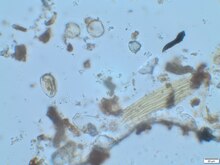
Lawn and ornamental use

Grasses are the primary plants used in lawns, which themselves derive from grazed
.Ornamental grasses, such as
Sports turf
Grass playing fields, courses and pitches are the traditional playing surfaces for many
Cricket

In cricket, the pitch is the strip of carefully mowed and rolled grass where the bowler bowls. In the days leading up to the match it is repeatedly mowed and rolled to produce a very hard, flat surface for the ball to bounce off.[57]
Golf
Grass on golf courses is kept in three distinct conditions: that of the rough, the fairway, and the putting green. Grass on the fairway is mown short and even, allowing the player to strike the ball cleanly. Playing from the rough is a disadvantage because the long grass may affect the flight of the ball. Grass on the putting green is the shortest and most even, ideally allowing the ball to roll smoothly over the surface. An entire industry revolves around the development and marketing of turf grass varieties.[58]
Tennis
In tennis, grass is grown on very hard-packed soil, and the bounce of a
Economically important grasses
|
|
|
|
A number of grasses are invasive species that damage natural ecosystems, including forms of Phragmites australis which are native to Eurasia but has spread around the world.[59][60]
Role in society



Grasses have long had significance in human society. They have been cultivated as feed for people and
In some places, particularly in suburban areas, the maintenance of a grass lawn is a sign of a homeowner's responsibility to the overall appearance of their neighborhood. One work credits lawn maintenance to:
...the desire for upward mobility and its manifestation in the lawn. As Virginia Jenkins, author of The Lawn, put it quite bluntly, "Upper middle-class Americans emulated aristocratic society with their own small, semi-rural estates." In general, the lawn was one of the primary selling points of these new suburban homes, as it shifted social class designations from the equity and ubiquity of urban homes connected to the streets with the upper-middle class designation of a "healthy" green space and the status symbol that is the front lawn.[62][63]
In communities with drought problems, watering of lawns may be restricted to certain times of day or days of the week.[64] Many US municipalities and homeowners' associations have rules which require lawns to be maintained to certain specifications, sanctioning those who allow the grass to grow too long.[65][66]
The smell of freshly cut grass is produced mainly by cis-3-Hexenal.[67]
Some common aphorisms involve grass. For example:
- "The grass is always greener on the other side" suggests an alternate state of affairs will always seem preferable to one's own.
- "Don't let the grass grow under your feet" tells someone to get moving.
- "A snake in the grass" means dangers that are hidden.
- "When elephants fight, it is the grass which suffers" tells of bystanders caught in the crossfire.
A folk myth about grass is that it refuses to grow where any violent death has occurred.[68]
Image gallery
-
Leaves of Poa trivialis showing the ligules
-
Bamboo stem and leaves, nodes are evident
-
A Chasmanthium latifolium spikelet
-
Wheat spike and spikelet
-
Spikelet opened to show caryopsis
-
Harestail grass
-
Grass
-
Sugarcane (Saccharum officinarum)
-
Roots of Bromus hordeaceus
-
Barley mature spikes (Hordeum vulgare)
-
Illustration depicting both staminate and pistillate flowers of maize (Zea mays)
-
A grass flower head (meadow foxtail) showing the plain-coloured flowers with large anthers
-
Anthers detached from a meadow foxtail flower
-
Setaria verticillata, bristly foxtail
-
Setaria verticillata, bristly foxtail
See also
References
- ^ .
- hdl:10654/18083.
- .
- from the original on 2016-07-29.
- ^ "Angiosperm Phylogeny Website". Archived from the original on 23 March 2016. Retrieved 20 March 2016.
- ^ "Rice is Life" (PDF). Food and Agricultural Organization of the United Nations. 2004. Archived from the original (PDF) on 2022-02-28.
- ^ Reynolds, S.G. "Grassland of the world". www.fao.org. Archived from the original on 2016-09-20. Retrieved 2016-10-04.
- ^ ISBN 9780901158420.
- ISBN 9781900347754.
- S2CID 264140616.
- ^ ISBN 978-0-563-20207-3.
- ISBN 978-3-642-04506-6.
- ISBN 978-0-19-852918-7.
- ^ PMID 22115274.

- ISBN 978-1-78023-313-0.
- JSTOR 2485402. Retrieved 5 June 2016.
- S2CID 83493897.
- S2CID 83493897.
- S2CID 1816461.
- PMID 21934664.
- PMID 22093967.
- .
- S2CID 84052108.

- ^ Sarandón, Ramiro (1988). Biología poblacional del gramon (Cynodon spp., Gramineae) (Tesis). Universidad Nacional de La Plata. p. 189. Archived from the original on 11 September 2014. Retrieved 22 April 2014.
- ^ "Angiosperm phylogeny website". Archived from the original on 2010-02-06. Retrieved 2007-10-07.
- ^ ISBN 978-0-8094-4520-2.
- ISBN 9781438130057. Archivedfrom the original on 2018-01-10.
- ISBN 978-0-521-57205-7.
- ISBN 978-90-04-09227-3.
- ISBN 978-0-7566-6908-9.
- ISBN 978-0-7167-7893-6.
- ^ "Chapter 1: How grasses grow". Farmwest.com. Archived from the original on 2013-09-10. Retrieved 2013-08-26.
- ISBN 978-0-520-27568-3.
- ISBN 978-0-8094-4520-2.
- ISBN 978-0-697-22213-8.
- ISBN 978-1-139-48906-5.
- ISBN 978-0-12-394808-3.
- ISBN 978-1-921208-22-5.
- ISBN 978-94-017-9609-5.
- ISBN 978-1-4419-0760-8.
- ISBN 978-1-61091-022-4.
- S2CID 17934192.
- ^ ISSN 0034-6667.
- ^ ISSN 0034-6667.
- ISSN 0017-3134.
- ^ Beug, Hans-Jürgen. "Leitfaden der Pollenbestimmung für Mitteleuropa und angrenzende Gebiete". (No Title).
- PMID 17978176.
- ^ S2CID 84086503.
- S2CID 21178634.
- S2CID 199104436.
- PMID 27999585.
- ISSN 2090-0120.
- ^ den Nijs, Joannes Cornelius Maria; Hooghiemstra, H.; Schalk, P.H. (1980). "Biosystematic studies of the Rumex acetosella complex (Polygonaceae). IV. Pollen morphology and the possibilities of identification of cytotypes in pollen analysis". Phyton; annales rei botanicae.
- ISBN 978-0-395-79761-7.
- ^ "Pats sign Testaverde; Gillette Stadium's grass field replaced with Field Turf - USATODAY.com". usatoday30.usatoday.com. Archived from the original on 2021-03-08. Retrieved 2019-12-10.
- ^ Tainton, Neil; van Deventer, Pietr. "Cricket pitches Principles and practice of pitch preparation". cricinfo. Archived from the original on 2017-06-09.
- ISBN 978-0-89118-613-7.
- ISBN 978-1-4822-3738-2.
- ISBN 978-90-481-9585-5.
- ISBN 978-93-87991-72-9.
- ^ Matthew J. Lindstrom, Hugh Bartling, Suburban sprawl: culture, theory, and politics (2003), p. 72, quoting Virginia Scott Jenkins, The Lawn: A History of an American Obsession (1994), p. 21.
- ISBN 978-1-4051-4921-1. Archivedfrom the original on 2023-02-23. Retrieved 2023-02-23.
- ^ "Lawn Sprinkling Regulations in Metro Vancouver, BC, Canada". Metrovancouver.org. 2011-02-21. Archived from the original on 2012-01-19. Retrieved 2013-08-26.
- ^ "Lawn Maintenance and Climate Change". PSCI. 12 May 2020. Archived from the original on 2021-10-28. Retrieved 2021-10-28.
- ISBN 978-1-60469-001-9.
- ^ "hexenal". School of Chemistry, University of Bristol. Archived from the original on 2013-10-09. Retrieved 2013-08-26.
- ISBN 0-684-80164-7.
External links
- Need a Definition of Grass?
- Vegetative Key to Grasses
- Poaceae at The Plant List
- Learn about grasses at The Story of the Poaceae
- . Encyclopædia Britannica. Vol. XI (9th ed.). 1880. pp. 53–60.
- Gramineae Archived 2007-01-03 at the Wayback Machine at The Families of Flowering Plants (DELTA) Archived 2007-01-03 at the Wayback Machine
- Poaceae at the Angiosperm Phylogeny Website
- Poaceae Classification from the online Catalogue of New World Grasses
- Poaceae Archived 2016-04-02 at the Wayback Machine at the online Guide to the Flora of Mongolia Archived 2013-01-29 at the Wayback Machine
- Poaceae at the online Flora of Taiwan
- Poaceae at the online Flora of Pakistan
- Poaceae at the online Flora of Zimbabwe
- Poaceae Archived 2012-04-01 at the Wayback Machine at the online Flora of Western Australia
- Grasses of Australia (AusGrass2) – AusGrass2 | Grasses of Australia
- Gramineae at the online Flora of New Zealand
- NZ Grass Key Archived 2012-05-11 at the Wayback Machine An Interactive Key to New Zealand Grasses at Landcare Research
- The Grass Genera of the World Archived 2006-10-07 at the Wayback Machine at DELTA intkey Archived 2007-01-03 at the Wayback Machine
- RGB Kew - The Online World Grass Flora
- GrassWorld



